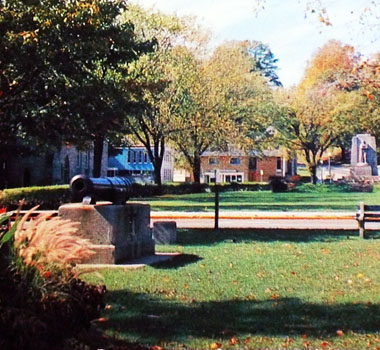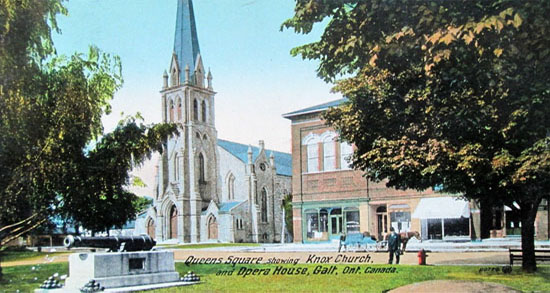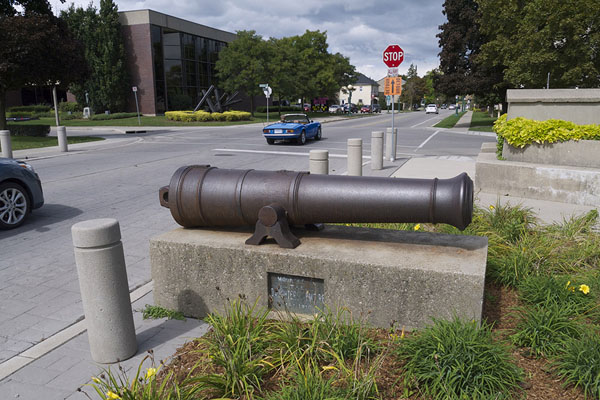
HOME





HOME
|

|

|

|

|
|
P R O F I L E |
||||
|
  CRIMEAN CANNONS - WHERE ARE THEY NOW?
CRIMEAN CANNONS - WHERE ARE THEY NOW?Queen's Square Cambridge formerly Galt Waterloo County, Ontario Canada Cambridge is a city located in Southern Ontario at the confluence of the Grand and Speed rivers in the Regional Municipality of Waterloo, Ontario, Canada. It was formed in 1973 by the amalgamation of the Galt, Preston, Hespeler, the settlement of Blair and a small portion of surrounding townships. The following account is based on editorial in the Cambridge Times in May 2017. The Robin's database records the Cambridge gun as number 29619 made in the 1840s, a 24 pdr from the Alexandrovski Works. When the Crimean War started in 1853 it was just another of the countless wars of empire waged by European nations. It was a war that produced the "balaclava" hat, which helped British soldiers endure the harsh Russian winter of 1854-55. It was a war of military ineptitude and senseless slaughter immortalized by Alfred Lord Tennyson's poem "Charge of the Light Brigade". It was also a war with significant local economic impact. No Canadian units fought in that war although a few men from the colony of Canada did serve in British regiments The war ended in 1856 a few months after the Russians were forced to evacuate the city of Sevastopol. The Russians destroyed the fort at Sevastopol before they evacuated but apparently not all of the city's cannons were destroyed and a number fell into British hands. These were shipped to England where they remained for a number of years. This coincided with the development of the rifled barrel thus making earlier cannon obsolete. Eventually it was decided to distribute them to municipalities throughout Britain and the empire. Galt, as a strong supporter of the Empire and as the largest municipality in Waterloo County, was chosen to receive one of the "Russian guns". In November 1864 Galt Council received a letter from the Governor-General Viscount Monck "ordering that one of the Crimean Guns be presented to the Town of Galt". The Council was grateful when the manager of the Great Western Railway offered to transport the 24 pound cannon with a six inch bore from Hamilton wharf to Galt free of charge. The cannon soon arrived and the local press announced on December 2, 1864 that the "Russian gun has been removed from the railway station and now stands awaiting its carriage in the centre of Queen's Square. It attracts considerable attention". The gun was initially mounted on a wooden carriage when put on display in Queen's Square. The "Russian gun" played a part in the 1866 celebrations to mark Queen Victoria's 47th birthday. It was planned that at 12 o'clock "a Royal Salute of 21 guns will be fire from the Russian gun". According to a contemporary account of Victoria Day, May 24, 1866 the celebration got off to a fine start. The Town bells began pealing at 6:00 a.m. and soon people were gathering for the day's activities. As noon approached final preparations were made for the firing of the cannon which had been moved from Queen's Square to the Cricket Ground. The firing of the cannon had been delegated by the Gun Committee to Mr. William Boge who had served for several years as an infantry soldier in the British Army. He lacked direct experience in the use of field artillery but felt himself to be fully acquainted with artillery practice. Mr. Boge was assisted by Mr. James Armstrong, who attended to the ramming of the muzzle loading the gun, and by Mr. David Galletly who was working the vent of the gun. Three rounds had been fired when the powder for the fourth round was placed in the muzzle. Next came the wadding, which consisted of sod, with Mr. Boge and Mr. Armstrong ramming it home. Suddenly and unexpectedly a fearful roar rent the holiday air as the powder exploded prematurely. The press recorded the shock and horror as the smoke cleared. "The body of Boge had been driven about seven yards to the front and a little to the right. Armstrong's body was blown about the same distance to the left side close up to the fence. Both were badly disfigured, The upper portions of the bodies were entirely denuded of clothing and blackened and charred almost out of human recongnition. From Mr. Boge's body one arm had been blown off at the elbow and the other hand was missing. Armstrong's right arm was torn out at the shoulder blade and the left hand was also gone". Mr. Galletly who had been attending to his duties at the vent when the accident occurred had his thumb badly lacerated and his hand burned. The only other injuries were to the two boys who had been watching the firing of the gun. One unnamed boy suffered a slightly scratched cheek from the flying splinter. Another boy, John Lapraik, 7 years of age, received an ugly cut on the cheek when he was struck by a small piece of ramrod. His wound was speedily treated and soon healed. Immediately following the accident the bodies of Mr. Armstrong and Mr. Boge were taken to the old school house on Dickson Street where an inquest was held at the direction of coroner, Dr. Phillips. Several witnesses were called, including David Galletly but none were able to give a satisfactory explanation of the direct cause of the premature firing of the gun. It was speculated however, that the firing was too rapid and that the cannon muzzle had not been adequately sponged after the third round was fired. It was thought that burning embers remained in the cannon and had ignited the powder charge too soon. The jury ruled, "that said William Boge and James Armstrong came to their deaths through accident caused by inexperience of the parties to whom the firing of the 24 pound gun was entrusted." The games that had been scheduled for the afternoon were cancelled as the Town's joy turned to sorrow and Galt prepared to bury its two sons. The coroner ordered that the bodies by buried without undue delay so the funeral was held at 8:00 p.m. that same evening at the old School House. Both deceased men had been members of the Galt Fire Brigade, which turned out in force to honour their fallen comrades. The bodies were placed on Fire Engine No. 1 and, after a short service conducted by the Rev. Mr. Campbell, were taken for burial to St. Andrew's Cemetery. For some time the accident scene was avoided by the Town's people and a full week after the accident the old cannon still stood on the brow of the hill as no one made any effort to move it to its old resting place in Queen's Square. It was almost as if the horror of the accident continued to hang over the cannon and few seemed willing to approach it. The gun was eventually returned to its resting place in Queen's Square but thereafter suffered a certain amount of neglect. In 1885 it was reported that the old cannon was in a sorry state as the carriage upon which it rested was rotting away. It is thought that the gun rested on another wooden frame until May 1910 when the Imperial Order of the Daughters of the Empire had the cannon remounted on a cement base. In the base was embedded the plaque: "Taken by the British at Sevastopal September 10, 1855. Given by Great Britain to Canada and brought to Galt." At about the same time the Defence Department is reported to have given the various municipalities, which possessed cannons, some 60 cannon balls. These were stacked in six pyramids of 10 cannon balls which flanked the cannon. The cannon balls were removed in the years following World War II because it was feared that the local children who insisted on playing with them might be hurt. 
Apparently Galt's Council did not believe that the federal government's request included the "Queen's Square relic" for they agreed to make available only guns from the Memorial Home and in Soper Park as well as the City's old Sawyer-Massey road roller. It can be concluded that Council assumed that since the letter from the Department of Munitions and Supply mentioned war trophies of World War I vintage, only those trophies, and not the older ones like the Crimean War cannon were needed. Whatever the reason, the "Russian gun" escaped the scrap pile and remains in Queen's Square, a witness of Galt's history and a gun with something of a history of its own. Below - a recent picture of the cannon. 
More recently Queen's Square was an untidy mess with the fountain area collecting more debris than water. The area was not the usual showcase of downtown Galt. In May 1910 the Daughters of the Empire had the Russian Gun remounted on the concrete base where it sits today. However over time greenery had overgrown the plaques on the piece of Galt's old history. Since then however the location has recently been manicured and things are looking up for Queen's Square. The budgeted cost of the work on the bridge and surrounding area kept creeping up until it hit $3.4 million, about a half million overrun. Now it's time to celebrate the new appearance around the square and the historical looking Main Street bridge. To read the full account of the above click on web site below from where this reduced and edited version originated. Also see the account in the Cambridge Times in May 2017. Website: Click Here ADDITIONAL INFORMATION  FACILITIES Access all Year, Access by Road, Access on Foot, Free Entry LANDSCAPE City Centre, Park or Garden, Rural REGION Located outside the United Kingdom THE FEATURES PRESENT Crimean Cannon Location, past or present |
||||
|